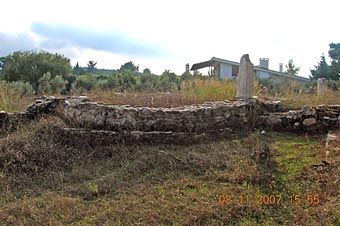Basilica, Mygdaleza
Area: Mygdaleza - Stamata
Type:
Date: 5th - 6th century
Description:
The ruins of this early Christian basilica lie on the hill Mygdaleza in Stamata, 2,5 km northwest of the village. It is a very important archeological site, since – apart from the ruins of this basilica – both ancient and more recent ruins (till the post Byzantine years) have come to light. The Mygdaleza basilica (end of the 5th – beginning of the 6th century) was three-aisled with an annexed baptistery in the southeast side of its main body, in the west of which existed two independent rooms that consisted the complex of the baptistery (photisterion and chrismarion = consognatorium). A twin built tomb was found next to the semi-circular apse of the sanctuary. It is nowadays displayed in the Athens Byzantine and Christian Museum. The church must have been destroyed towards the end of the 7th and the beginning of the 8th century, a period when most of the early Christian monuments of the country were destroyed due to the Slavic and Arabic raids. During the 11th century, the veneration in the area is revived although restricted to a middle aisle part, while the area around it functions as a cemetery, as concluded by the excavated tombs. In the end of the 19th century the existence of this single-naved church is attested. It was built in the middle aisle of the basilica and it must have functioned during the years of the Turkish domination. The church is mentioned as Hagia Paraskevi or as Hagios Nikolaos.
Type:
Date: 5th - 6th century
Description:
The ruins of this early Christian basilica lie on the hill Mygdaleza in Stamata, 2,5 km northwest of the village. It is a very important archeological site, since – apart from the ruins of this basilica – both ancient and more recent ruins (till the post Byzantine years) have come to light. The Mygdaleza basilica (end of the 5th – beginning of the 6th century) was three-aisled with an annexed baptistery in the southeast side of its main body, in the west of which existed two independent rooms that consisted the complex of the baptistery (photisterion and chrismarion = consognatorium). A twin built tomb was found next to the semi-circular apse of the sanctuary. It is nowadays displayed in the Athens Byzantine and Christian Museum. The church must have been destroyed towards the end of the 7th and the beginning of the 8th century, a period when most of the early Christian monuments of the country were destroyed due to the Slavic and Arabic raids. During the 11th century, the veneration in the area is revived although restricted to a middle aisle part, while the area around it functions as a cemetery, as concluded by the excavated tombs. In the end of the 19th century the existence of this single-naved church is attested. It was built in the middle aisle of the basilica and it must have functioned during the years of the Turkish domination. The church is mentioned as Hagia Paraskevi or as Hagios Nikolaos.












